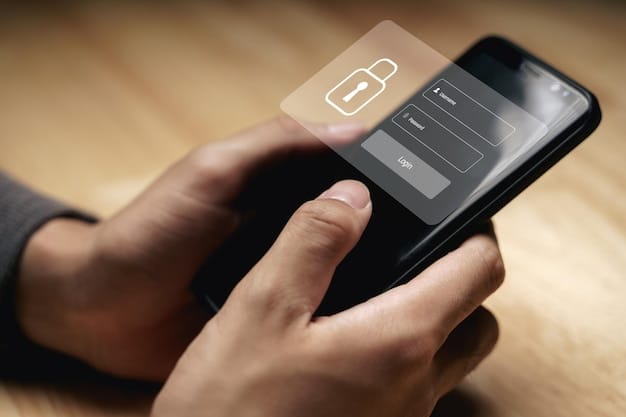Mobile Device Security: A Cybersecurity Guide for Company Data Protection

Mobile device security is crucial for protecting company data on employee devices, requiring a comprehensive approach that includes robust policies, employee training, and advanced security measures to mitigate risks effectively.
In today’s interconnected business environment, mobile devices have become indispensable tools for employees. However, this convenience comes with significant cybersecurity risks. This cybersecurity guide: Mobile device security: Protecting company data on employee devices is designed to help businesses understand and mitigate these risks, ensuring that sensitive information remains secure, even when accessed on the go.
Understanding the Risks: Mobile Devices and Data Security
Mobile devices, such as smartphones and tablets, are now integral to daily business operations. However, they also represent a significant vulnerability in an organization’s cybersecurity posture. Understanding the risks associated with mobile devices is the first step in implementing effective security measures.
Common Security Threats to Mobile Devices
Mobile devices are susceptible to a variety of security threats, including malware, phishing attacks, and data breaches. These threats can compromise sensitive company information, leading to financial losses and reputational damage.
The Impact of Mobile Devices on Data Security
Mobile devices often store or access sensitive company data, making them a prime target for cybercriminals. The loss or theft of a mobile device can result in unauthorized access to critical information, leading to severe consequences.
- Malware Infections: Mobile malware can steal data, track user activity, and compromise device security.
- Phishing Attacks: Phishing scams can trick users into revealing sensitive information through deceptive emails or messages.
- Unsecured Networks: Connecting to public Wi-Fi networks can expose mobile devices to cyber threats.
- Outdated Software: Failure to update mobile operating systems and apps can leave devices vulnerable to exploits.
Recognizing these risks is vital for developing a robust mobile device security strategy. By understanding the specific threats that mobile devices pose, organizations can take proactive steps to protect their data and systems from cyberattacks.
Establishing a Mobile Device Security Policy
A well-defined mobile device security policy is essential for protecting company data on employee devices. This policy should outline clear guidelines and procedures for the secure use of mobile devices, ensuring that employees understand their responsibilities in maintaining data security.
Key Components of a Mobile Device Security Policy
A comprehensive mobile device security policy should cover various aspects of device usage, including password requirements, data encryption, and acceptable use guidelines. It should also address the procedures for reporting lost or stolen devices.
Implementing and Enforcing the Policy
Effective implementation of the mobile device security policy requires clear communication and ongoing training. Employees should be educated about the policy’s requirements and the potential consequences of non-compliance.

- Password Management: Require strong, unique passwords and encourage the use of password managers.
- Data Encryption: Implement full-disk encryption to protect data at rest on mobile devices.
- Acceptable Use Guidelines: Define the permissible uses of mobile devices for business purposes.
- Incident Reporting: Establish a clear process for reporting security incidents, such as lost or stolen devices.
By establishing and enforcing a mobile device security policy, organizations can create a culture of security awareness and reduce the risk of data breaches. Regular reviews and updates of the policy are necessary to address evolving threats and technological changes.
Securing Mobile Devices: Best Practices
Implementing best practices for securing mobile devices is critical for protecting company data. These practices should cover various aspects of device security, from device configuration to software management, ensuring a layered approach to protection.
Device Configuration and Management
Proper device configuration is essential for maintaining a secure mobile environment. This includes setting up strong passwords, enabling remote wipe capabilities, and configuring device security settings.
Software and Application Management
Managing software and applications on mobile devices is crucial for preventing security vulnerabilities. This involves keeping operating systems and apps up-to-date, as well as implementing application whitelisting to prevent the installation of malicious software.
- Regular Software Updates: Ensure that mobile operating systems and apps are regularly updated with the latest security patches.
- Application Whitelisting: Implement a policy that allows only approved applications to be installed on mobile devices.
- Mobile Device Management (MDM): Use MDM solutions to remotely manage and secure mobile devices, including enforcing security policies and tracking device location.
- Remote Wipe Capabilities: Enable remote wipe functionality to erase data from lost or stolen devices.
By following these best practices, organizations can significantly reduce the risk of mobile device-related security breaches. Regular security audits and assessments can help identify and address potential vulnerabilities in the mobile environment.

Employee Training and Awareness
Employee training and awareness are vital components of any mobile device security strategy. Educating employees about the risks associated with mobile devices and the importance of following security policies can significantly reduce the likelihood of security breaches.
Educating Employees on Security Risks
Training programs should cover a range of topics, including phishing awareness, password security, and safe browsing habits. Employees should also be informed about the potential consequences of non-compliance with security policies.
Promoting Security Awareness
Regular security awareness campaigns can help reinforce security best practices and keep employees informed about the latest threats. These campaigns can include newsletters, posters, and interactive training sessions.
Comprehensive training programs that include:
- Phishing Simulations: Conduct regular phishing simulations to test employee awareness and identify areas for improvement.
- Password Security Training: Provide guidance on creating strong passwords and using password managers.
- Safe Browsing Practices: Educate employees on how to identify and avoid malicious websites and links.
- Data Protection Guidelines: Reinforce the importance of protecting sensitive company data and complying with data protection regulations.
By investing in employee training and awareness, organizations can create a security-conscious workforce that is better equipped to protect company data on mobile devices.
Advanced Security Measures for Mobile Devices
In addition to basic security measures, organizations should consider implementing advanced security technologies to enhance mobile device protection. These technologies can provide an extra layer of defense against sophisticated cyber threats.
Mobile Threat Defense (MTD) Solutions
MTD solutions offer real-time threat detection and prevention, protecting mobile devices from malware, phishing attacks, and other security threats. These solutions can also identify and mitigate vulnerabilities in mobile apps and operating systems.
Virtual Private Networks (VPNs)
VPNs encrypt internet traffic, providing a secure connection for mobile devices when accessing company resources. This is particularly important when using public Wi-Fi networks, which are often unsecured.
Advanced security measures that include:
- Biometric Authentication: Implement biometric authentication, such as fingerprint scanning or facial recognition, to enhance device security.
- Data Loss Prevention (DLP): Use DLP solutions to prevent sensitive data from being transmitted or stored on mobile devices without authorization.
- Secure Containers: Create secure containers on mobile devices to isolate and protect sensitive company data from personal apps and data.
- Endpoint Detection and Response (EDR): Utilize EDR solutions designed for mobile devices to detect and respond to advanced threats in real-time.
By incorporating advanced security measures, organizations can strengthen their defenses against mobile device-related cyberattacks and protect sensitive company data from compromise.
Monitoring and Incident Response
Effective monitoring and incident response capabilities are essential for detecting and responding to security incidents involving mobile devices. These capabilities enable organizations to identify and mitigate threats quickly, minimizing the potential impact on company data and systems.
Establishing a Monitoring Framework
A robust monitoring framework should include real-time monitoring of mobile device activity, as well as regular security audits and vulnerability assessments. This framework should also incorporate threat intelligence feeds to stay informed about the latest threats.
Incident Response Procedures
Incident response procedures should outline the steps to be taken in the event of a security breach involving a mobile device. This includes isolating the affected device, containing the incident, and conducting a thorough investigation to determine the cause and extent of the breach.
Key components of robust monitoring and incident response:
- Security Information and Event Management (SIEM): Integrate mobile device security logs with SIEM systems to detect and respond to security incidents in real-time.
- Automated Incident Response: Implement automated incident response capabilities to quickly contain and mitigate security breaches.
- Regular Security Audits: Conduct regular security audits to identify and address potential vulnerabilities in the mobile environment.
- Incident Response Team: Establish a dedicated incident response team responsible for handling security incidents involving mobile devices.
By implementing effective monitoring and incident response capabilities, organizations can minimize the impact of mobile device-related security breaches and protect their critical assets from cyber threats.
| Key Point | Brief Description |
|---|---|
| 🔒 Security Policy | Establish a comprehensive policy for mobile device usage. |
| 🛡️ Best Practices | Implement best practices for device configuration and software management. |
| 🧑🏫 Training | Regular training to educate employees on security risks. |
| 🚨 Monitoring | Monitor device activity and ensure compliance with incident response procedures. |
Frequently Asked Questions (FAQ)
▼
MDM is a software solution that allows IT administrators to remotely manage and secure mobile devices used in an organization. It includes features like device configuration, security policy enforcement, and remote wipe capabilities.
▼
Updating mobile operating systems is crucial as updates often include security patches that address newly discovered vulnerabilities. Failing to update can leave devices exposed to known exploits and malware.
▼
To protect against phishing, be cautious of suspicious emails or messages, avoid clicking on unknown links, and verify the sender’s identity. Use security apps that flag potential phishing attempts.
▼
Immediately report the lost or stolen device to your IT department. They can remotely wipe the device to prevent unauthorized access to company data and track its location if possible.
▼
Yes, VPNs are highly recommended for mobile devices, especially when using public Wi-Fi. They encrypt internet traffic, providing a secure connection to protect sensitive data from interception by cybercriminals.
Conclusion
Protecting company data on employee mobile devices requires a comprehensive and proactive approach. By implementing robust security policies, providing employee training, and utilizing advanced security technologies, organizations can significantly reduce the risk of mobile device-related security breaches. Continuous monitoring and incident response capabilities are also essential for detecting and mitigating threats quickly, ensuring the ongoing security of sensitive information.





